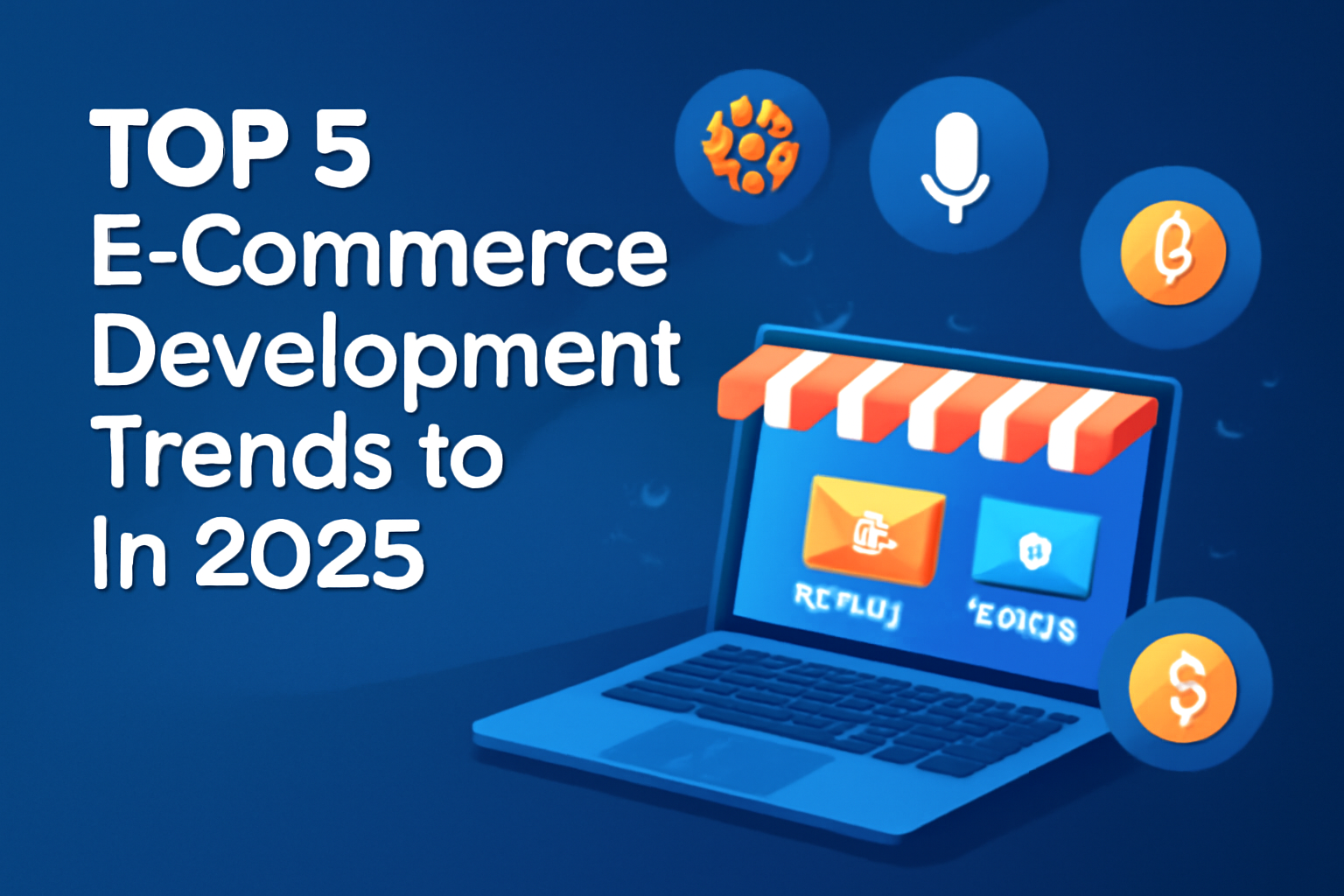Blog Details

Top 5 E-Commerce Development Trends to Watch in 2025
Introduction
The e-commerce industry has undergone significant transformation in recent years, driven by advancements in technology and shifts in consumer behavior. As we enter 2025, businesses are faced with new opportunities and challenges. To remain competitive, brands must adapt to the latest trends shaping the e-commerce space. This blog explores five key e-commerce development trends that will dominate in 2025, from AI-driven personalization to cryptocurrency payments.
AI-Powered Personalization
Personalization has been a growing trend in e-commerce, but in 2025, artificial intelligence (AI) will take it to the next level. AI-powered personalization allows brands to offer hyper-targeted shopping experiences based on individual consumer behaviors, preferences, and purchase history.
Key Benefits:
- Personalized Recommendations: AI can analyze a customer’s browsing history, behavior, and preferences to recommend products they are most likely to purchase.
- Dynamic Pricing: AI can adjust prices in real time based on market demand, competition, and customer behavior, ensuring the best pricing strategy.
- Enhanced Customer Experience: With personalized marketing messages and product suggestions, businesses can create a more engaging and customer-centric shopping experience.
Example: Companies like Amazon and Netflix have already leveraged AI to provide personalized recommendations. By 2025, this technology will become mainstream across e-commerce platforms, improving conversion rates and customer loyalty.
Voice Commerce
As voice assistants like Amazon Alexa, Google Assistant, and Siri become more integrated into daily life, voice commerce is on the rise. Consumers are now using their voice to search for products, make purchases, and interact with brands, making it a significant trend to watch in 2025.
Key Benefits:
- Hands-Free Shopping: Voice commerce allows users to shop while cooking, exercising, or multitasking, offering convenience that traditional e-commerce cannot.
- Faster Transactions: With voice commands, customers can quickly reorder products or make payments without the need to navigate through lengthy checkout processes.
- Improved User Engagement: Brands that embrace voice commerce will provide a more seamless and engaging shopping experience.
Example: Walmart and Target have already begun experimenting with voice-activated shopping, allowing customers to add products to their cart simply by speaking to their voice assistant.
Augmented and Virtual Reality Shopping
Augmented Reality (AR) and Virtual Reality (VR) are transforming how consumers interact with e-commerce. In 2025, we can expect even more widespread use of AR and VR to enhance the shopping experience, allowing customers to visualize products in real life before making a purchase.
Key Benefits:
- Try Before You Buy: AR technology allows customers to "try on" clothes, shoes, and accessories virtually, helping them make better purchasing decisions.
- Immersive Shopping Experiences: VR can take customers on virtual tours of stores or allow them to experience products in a 360-degree environment, making online shopping feel more like an in-store experience.
- Reduced Returns: By allowing customers to see how a product will fit into their home or wardrobe, AR and VR help reduce the likelihood of returns.
Example: IKEA’s AR app lets customers see how furniture will look in their home, while L'Oreal’s AR try-on feature allows users to virtually test makeup products.
Subscription-Based Models
The subscription model has gained traction across industries, from meal kits to entertainment. In 2025, subscription-based e-commerce will continue to grow, offering consumers convenience and cost savings.
Key Benefits:
- Recurring Revenue: For businesses, subscriptions provide predictable revenue streams, which are essential for long-term sustainability.
- Personalized Experiences: Subscription services often offer tailored products based on the customer’s preferences, improving the overall customer experience.
- Customer Retention: Subscriptions keep customers engaged with the brand, fostering loyalty and reducing churn.
Example: Dollar Shave Club and Birchbox revolutionized their industries with subscription models. As more consumers embrace the convenience of subscription services, more e-commerce businesses will adopt this model.
Cryptocurrency Integration
With the increasing adoption of cryptocurrencies like Bitcoin, Ethereum, and Litecoin, integrating cryptocurrency payments into e-commerce platforms is becoming essential for businesses looking to stay ahead of the curve.
Key Benefits:
- Global Reach: Cryptocurrencies allow businesses to tap into a global market without the need for traditional banking or currency exchange.
- Reduced Transaction Fees: Cryptocurrency transactions often come with lower fees compared to traditional payment methods, reducing costs for both businesses and customers.
- Enhanced Security: Blockchain technology ensures secure and transparent transactions, building trust with consumers.
Example: Brands like Overstock and Newegg already accept Bitcoin as payment, and by 2025, more e-commerce platforms are expected to follow suit.
Conclusion
As the e-commerce world continues to evolve, staying ahead of the trends is crucial for maintaining a competitive edge. By embracing AI-powered personalization, voice commerce, AR/VR shopping, subscription models, and cryptocurrency integration, businesses can ensure that their e-commerce platforms are future-proof and aligned with consumer expectations in 2025.
Call-to-Action
Ready to future-proof your e-commerce business? Contact NexCodeForge today to discuss how we can help you integrate the latest e-commerce trends and create a seamless, innovative shopping experience for your customers.
Thanks for breaking this down so clearly — not many blogs go into this much detail.
Hemant
This is exactly what I was looking for. Appreciate you taking the time to write it.
Himanshu
I always enjoy your posts — they’re practical and easy to follow. Keep sharing more!
Shivi

Leave a Reply
Your email address will not be published.